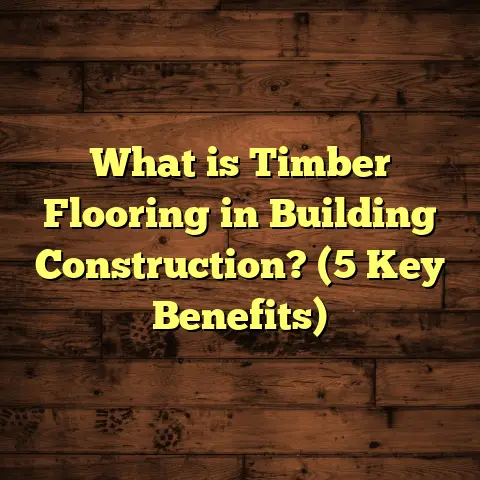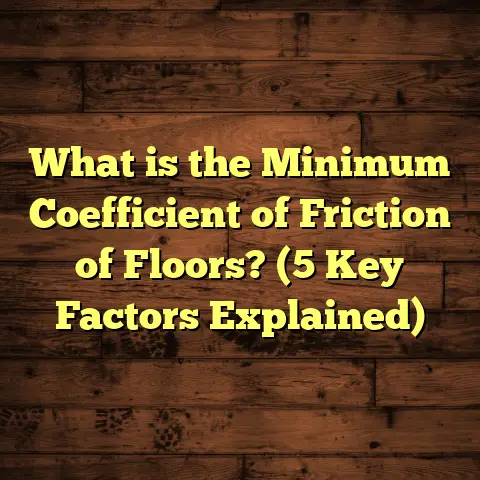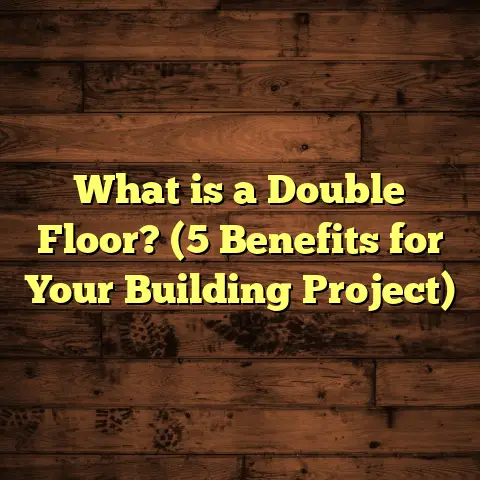What is an Engineered Timber Floor? (5 Benefits You Must Know!)
Addressing climate-specific needs has been a game-changer for me when recommending flooring options. Living in a region with fluctuating humidity and occasional temperature swings, I quickly realized that not every flooring type can stand up to the challenge. That’s when I started working closely with engineered timber floors and found they often check all the boxes. Over the years, I’ve gathered a mountain of experience, stories, and data about these floors that I want to share with you. So grab a cup of coffee, sit back, and let’s chat about engineered timber floors in detail.
What is Engineered Timber Floor?
So, what exactly is an engineered timber floor? Let me break it down for you like I would to a friend over coffee.
An engineered timber floor is made up of several layers of wood, stacked and glued together. The top layer, called the wear layer, is a thin slice of real hardwood. Beneath it, multiple layers of plywood or high-density fiberboard (HDF) are arranged in a crisscross pattern. This structure makes it much more stable than solid hardwood floors, especially when exposed to moisture or temperature changes.
Unlike traditional solid hardwood—which is just one thick piece of wood—engineered timber combines the beauty of natural wood with modern engineering. This design keeps the floor from expanding or contracting too much, which can cause warping or gaps. I’ve seen this firsthand in homes where solid wood floors failed but engineered timber stayed perfect.
A Bit More on How It’s Made
The manufacturing process is pretty fascinating. The core layers are glued under heat and pressure, making a super-strong base. Then, the top hardwood veneer is carefully applied and finished to give you that authentic wood look. Depending on the brand, finishes can be oil-based, UV-cured, or even hand-scraped for texture.
As someone who’s installed countless floors, I appreciate how this construction balances durability and aesthetics. You get the warmth and character of real wood without some of the headaches that come with solid planks.
5 Benefits You Must Know About Engineered Timber Floors
Now, you might be wondering why so many people—including me—are choosing engineered timber floors these days. Let’s get into five big benefits that make this flooring stand out.
1. Handles Humidity and Temperature Fluctuations Like a Champ
One thing I always ask clients about is their local climate. If you’re near the coast or in an area with high humidity swings, engineered timber floors are your best bet.
Why? The layered construction allows it to resist warping and cupping when moisture levels change. In fact, studies show engineered floors expand up to 40% less than solid hardwood under humid conditions. That means fewer gaps between boards or buckling issues.
A recent project I worked on in Florida was a perfect example. The homeowner had solid oak floors that kept swelling each summer. We replaced them with engineered timber, and after two years they still look flawless despite the humid climate.
The cross-layered core gives strength in multiple directions, something solid wood doesn’t have. This is why it’s often recommended for basements and kitchens where moisture can be an issue.
2. Easier Installation Saves Time and Money
Here’s something that might surprise you: engineered timber floors can be installed faster than solid wood floors.
Because of their stability, they’re compatible with more installation methods—floating, glue-down, or nail-down—making them versatile for different subfloors like concrete or plywood.
On one job, I installed a 1,000 sq ft engineered floor in just three days using a floating method, compared to the week it would have taken for solid hardwood.
This flexibility also means fewer callbacks for repairs down the line, saving both time and money.
Also worth noting: many engineered timber planks come with click-lock systems that make DIY installation very doable. I’ve seen people with no prior flooring experience put down beautiful floors over a weekend with minimal fuss.
3. Looks Just Like Real Hardwood (Because It Is)
Let’s not beat around the bush—the top layer is real hardwood.
You get all the grain patterns, color variations, and natural warmth of solid wood. Plus, you can choose from classic species like oak, walnut, maple, or exotic options like Brazilian cherry.
In my experience, clients often tell me they can’t tell the difference between engineered timber and solid hardwood once it’s installed—especially after a good finish is applied.
And if you love the idea of rustic or hand-scraped floors but worry about price or durability? Engineered timber often offers those styles too, sometimes at a fraction of the cost of solid wood.
4. Sustainable and Environmentally Friendly Choice
For those concerned about sustainability (and many of my friends are), engineered timber floors have some clear perks.
Because the top veneer layer is thinner—usually 2-6mm thick—it uses less slow-growing hardwood per plank compared to solid wood floors. The inner layers often use fast-growing or recycled wood species.
I’ve worked on eco-friendly builds where specifying engineered timber helped achieve green certifications like LEED or BREEAM because of lower environmental impact.
Plus, many manufacturers source their wood responsibly and have certifications such as FSC (Forest Stewardship Council).
If you care about reducing waste too, engineered timber generates less wood waste during production since thinner slices are used on top and cores can be assembled from scraps or lower-grade woods.
5. Long-Lasting with Proper Care
People often ask me if engineered timber floors last as long as solid hardwood. The answer? Absolutely—if you take care of them right.
The wear layer can be sanded and refinished multiple times depending on its thickness. A layer that’s at least 3mm thick can typically be sanded 2-3 times during its lifespan, extending the floor’s life by decades.
One client of mine has had their floor for over 15 years and recently refinished it to look brand new again.
Engineered timber floors also resist dents and scratches better than some softer woods because of their engineered core’s stability.
What Makes Engineered Timber Floors Stand Out in Different Climates?
Living in various places over the years—from humid coastal areas to dry inland states—I’ve seen how different climates affect flooring choices greatly.
High-Humidity Areas
Here’s a quick story: A client in New Orleans had persistent problems with their solid hardwood floors swelling during rainy seasons. After switching to engineered timber floors with moisture-resistant cores, they noticed zero issues even after heavy storms.
Science backs this up too. Engineered timber’s cross-ply construction resists moisture absorption better than traditional wood. The dimensional stability can reduce expansion and contraction by up to 50% compared to solid wood in humid environments.
Dry and Arid Climates
In very dry regions like Arizona or parts of Australia, some homeowners worry about wood cracking or shrinking. Engineered flooring handles this well because its glued layers reduce movement caused by dryness.
I’ve seen homes in desert climates where solid wood floors cracked after just a few years, but nearby houses with engineered timber still looked flawless after a decade.
Seasonal Temperature Changes
What about places with wide temperature swings? Think Minnesota or Canada.
Engineered floors are more forgiving here because they don’t respond as dramatically to heat or cold shifts. This means fewer creaks and less chance of boards separating during winter or summer changes.
My Personal Experience Installing Engineered Timber Floors
I remember one particular project where a family wanted natural wood flooring but lived in a coastal city known for salty air and high humidity. They’d had bad luck before with solid hardwood that warped quickly.
We chose an engineered timber floor with a thick oak veneer and plywood core treated for moisture resistance. Installation went smoothly using a floating method over their existing concrete slab with a moisture barrier underneath.
Two years later when I visited for maintenance advice, the homeowners were thrilled—no gaps or warping at all despite regular storms and beach proximity.
Another time, I helped renovate an old Victorian house where subfloor conditions were uneven. Engineered timber’s flexibility allowed us to install a floating floor without major subfloor repairs—saving time and budget while keeping that classic wood look intact.
Digging Into Data: Industry Stats on Engineered Timber Flooring
You may wonder how popular these floors really are and if they’re trusted by professionals worldwide.
Here are some figures I found interesting:
- According to the Hardwood Flooring Manufacturers Association (HFMA), engineered timber sales have increased by over 25% annually over the past five years globally.
- A survey by HomeAdvisor showed more than 70% of homeowners preferred engineered timber over laminate or vinyl when asked about real-wood-looking options.
- Studies measuring dimensional stability found engineered timber expands 30-40% less than solid hardwood under high humidity conditions.
- Life-cycle assessments suggest engineered timber has a lower carbon footprint than traditional hardwood due to efficient material use and longer lifespan potential when maintained properly.
What About Maintenance? Keeping Your Floor Looking Great
One question I often get: “How do I care for my engineered timber floor?”
Maintenance is pretty straightforward but knowing the right steps can help extend your floor’s life:
- Regular cleaning: Use a soft broom or vacuum designed for hard floors to remove dirt and grit that can scratch surfaces.
- Damp mopping: Use a slightly damp mop—not soaking wet—with specially formulated wood floor cleaners. Avoid harsh chemicals or abrasive tools.
- Avoid moisture: Wipe spills immediately to prevent damage to the wood veneer.
- Furniture pads: Place felt pads under heavy furniture legs to protect against dents.
- Refinishing: Depending on wear layer thickness, sanding and refinishing can refresh your floor every 7-10 years or more.
I’ve seen clients treat their floors well and keep them looking like new for over 20 years!
Comparing Engineered Timber With Other Flooring Options
Sometimes people ask me how engineered timber stacks up against options like laminate, vinyl plank, or solid hardwood.
Here’s my take:
| Feature | Engineered Timber | Solid Hardwood | Laminate | Vinyl Plank |
|---|---|---|---|---|
| Real Wood Surface | Yes (top veneer) | Yes | No | No |
| Stability in Moisture | High | Low | Moderate | Very High |
| Installation Flexibility | High (various methods) | Moderate (mostly nail-down) | Very High (click-lock) | Very High (click-lock) |
| Cost | Moderate | High | Low | Low |
| Refinishing Possible | Yes (limited by wear layer thickness) | Yes (multiple times) | No | No |
| Environmental Impact | Lower (efficient material use) | Higher (solid wood use) | Depends on materials | Depends on materials |
| Comfort Underfoot | Moderate | Moderate | Low | Moderate |
This table sums up why many homeowners pick engineered timber when they want real wood beauty without some limits of solid hardwood.
How to Choose the Right Engineered Timber Floor for You
If you’re convinced but wondering where to start picking your floor, here are some tips from my experience:
1. Check Wear Layer Thickness
Thicker wear layers mean more refinishing potential down the road — aim for at least 3mm if long-term durability matters to you.
2. Pick Your Wood Species Wisely
Oak is classic and durable; maple is hard but lighter; walnut brings rich color; exotic species offer unique looks but sometimes cost more.
3. Consider Finish Type
Oil finishes penetrate wood giving natural look but require more upkeep; polyurethane finishes are tougher but less natural feeling.
4. Think About Installation Method
Floating floors are easier and great for DIY; glue-down offers strong adhesion but takes longer; nail-down is traditional for plywood subfloors.
5. Ask About Certifications
Look for FSC certification or other eco-labels if sustainability is important to you.
A Few Common Questions I Hear — Answered!
Q: Can I install engineered timber over radiant heating?
A: Yes! It’s one of the best choices for radiant heat because it expands less than solid wood and transfers heat efficiently.
Q: Will pets damage my engineered floor?
A: Like any wood floor, scratches are possible but engineered timber’s wear layer and finish can resist minor scratches better than softer woods.
Q: Can I refinish my floor myself?
A: If you have experience sanding floors, yes; otherwise it’s safer to hire pros since improper sanding could damage thin veneer layers.
Q: How long does installation usually take?
A: Depending on size and method, anywhere from 2 days for small rooms using floating installs to a week for larger glue-down projects.
Wrapping Up My Thoughts on Engineered Timber Floors
After working on hundreds of flooring projects across various climates and styles, I keep coming back to engineered timber floors as one of the smartest choices out there—especially if your climate plays tricks on wood or you want real hardwood looks without some hassles that come with solid planks.
They offer beautiful aesthetics combined with practical benefits like moisture resistance, installation flexibility, sustainability credentials, and long-lasting durability when cared for properly.
Whether you’re renovating a coastal cottage battered by humidity or upgrading a modern urban apartment seeking warmth underfoot—engineered timber has something to offer you.
If you ever want advice tailored to your home’s unique needs or want me to walk you through specific product options based on your budget and style preferences—just ask! I’m always happy to help friends make smart decisions about their floors because good flooring truly changes how you feel at home every day.
Let me know if you’d like me to dive into specific installation techniques next time or share product recommendations based on current market trends—I’ve got plenty more stories and data up my sleeve!





